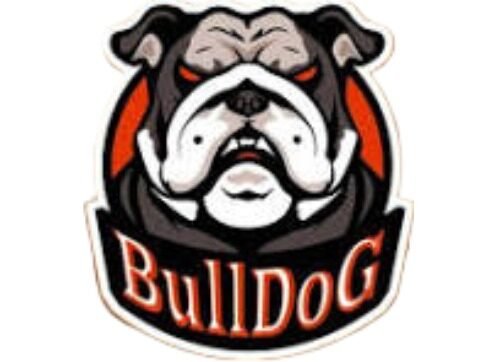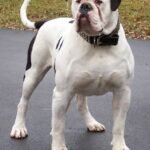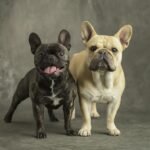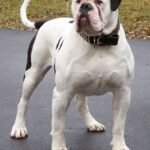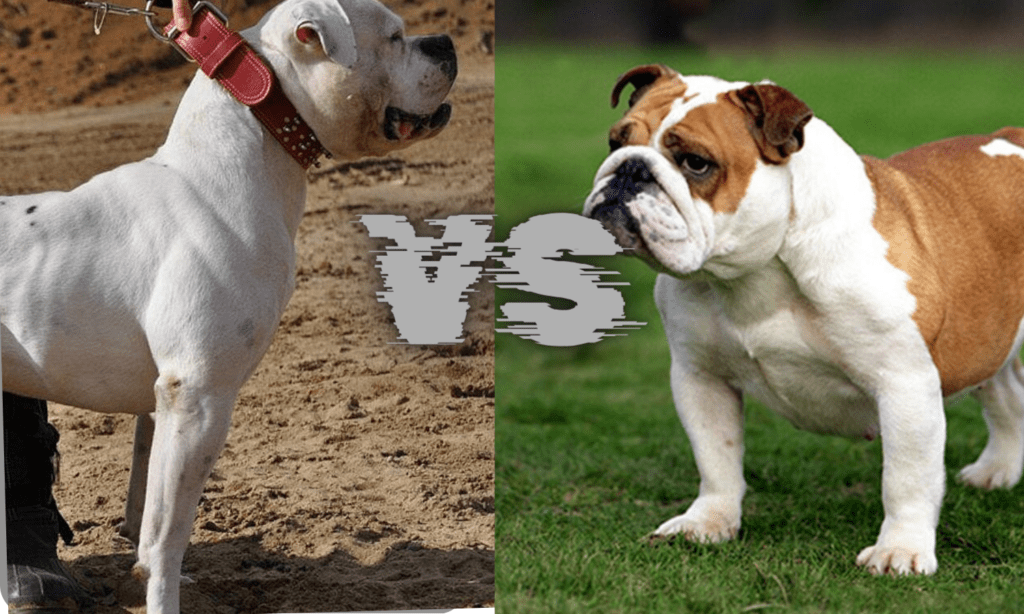
The Old English Bulldog and the English Bulldog have a lot of similarities but they have their sets of unique characteristics. Let’s break it down and start with appearance differences. The Old English Bulldog is more muscular than the English Bulldog. The English Bulldog is not an athletic canine; for some, a walk around the block is extremely taxing. The goal of Old English Bulldog breeders is to produce an animal that can compete in common dog sports, such as agility, or accompany an owner on long walks. While wrinkles are part of the English Bulldog’s appeal, as well as a breeding ground for skin infections, the Old English Bulldog’s skin shouldn’t be excessively wrinkled. Most importantly, the Old English Bulldog’s muzzle is longer and his nostrils wide.
Origins and Breed Characteristics of the Old English Bulldog and the English Bulldog
The Old English Bulldog is a crossbreed of the American Bulldog, the English Bulldog, the Bull Mastiff, and the American Pitbull Terrier. It is a muscular medium-sized dog breed that displays agility, strength, and stability while possessing a friendly temperament. The English Bulldog, also popularly known as the British Bulldog, Churchill Dog, and Bulldog, is a dog breed that originated in Europe. Initially bred for bull baiting, which was a violent sport back in the 1500s, the English Bulldog is a short, muscular dog that is extremely gentle, friendly, and protective of its human companions.
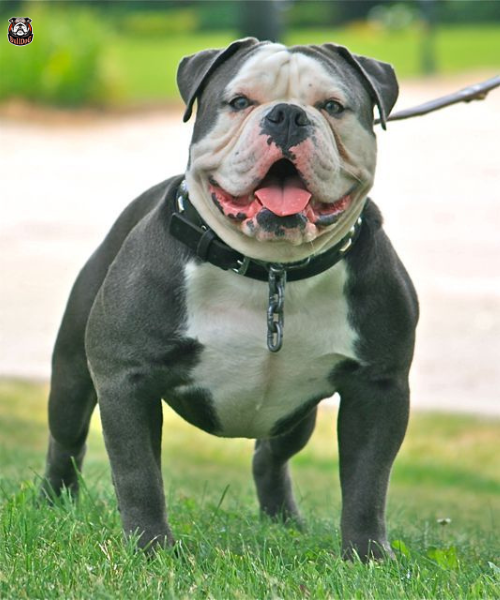
Size Comparison Between the Old English Bulldog and the English Bulldog
The English Bulldog is generally smaller than the Old English Bulldog.
- Old English Bulldog:
- Males: 17 to 20 inches tall at the shoulder and weigh between 60 to 80 pounds.
- Females: 16 to 19 inches tall and weigh between 50 to 70 pounds.
In contrast, English Bulldogs are shorter and more compact, typically standing around 14 to 15 inches tall and weighing about 40 to 50 pounds for both males and females
Training Differences Between the Old English Bulldog and the English Bulldog
Old English Bulldogs naturally want to please you and are an intelligent breed, so training isn’t difficult. However, they are very strong, so it is vital to have a well-trained dog who is obedient to avoid any issues arising. Use lots of positive reinforcement for training and keep it fairly short but often if you are training a puppy. The English Bulldog is smart but he can be a challenge to train, even with easier tricks. That’s because these pups prefer to think for themselves rather than follow commands. However, attending early socialization and obedience classes can ensure that your Bulldog puppy grows to be as respectful and mannerly as any other breed. You don’t want a stubborn little guy like the Bulldog to end up with bad habits.
Family Life with Old English Bulldogs and English Bulldogs
Both Old English Bulldogs and English Bulldogs make excellent family pets. They are great with kids and can adapt to living with other pets if they are socialized properly from a young age. Here are some key points about each breed:
- Old English Bulldogs:
- They have a slightly higher prey drive, so you need to be cautious if you have cats. Correct any chasing behavior early.
- They are friendly and can live well with other pets if socialized as puppies.
- English Bulldogs:
- They are independent and can be stubborn, making them harder to train.
- They respond well to food rewards, which can help with training.
- Some may develop separation anxiety, so it’s important to create a calm home environment to prevent this.
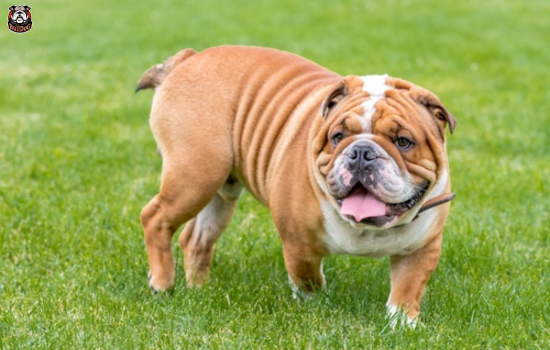
Grooming Needs for Old English Bulldogs and English Bulldogs
Both Old English Bulldogs and English Bulldogs are low-maintenance when it comes to grooming. Here’s what you need to know:
- Brushing:
- A gentle brushing with a soft bristle brush a few times a week keeps their coats shiny and healthy.
- Shedding increases in spring and fall, so you’ll need to brush them more often during these times.
- Bathing:
- Bulldogs generally don’t have a strong doggy odor, so they don’t need frequent baths.
- Wrinkle Care:
- The most crucial part of grooming is taking care of the wrinkles on their faces.
- Clean the wrinkles with a soft, damp cloth daily, or at least twice a week.
- After cleaning, dry the wrinkles gently to prevent moisture, which can lead to bacterial infections.
Feeding Requirements for Old English Bulldogs and English Bulldogs
Both breeds typically require two and a half to three and a half cups of dog food per day. However, Bulldogs don’t regulate their appetite well, so feeding should be done at regular intervals throughout the day rather than free-feeding to prevent obesity and related health issues.
- Meal Management:
- Bulldogs need structured feeding times; free-feeding can lead to obesity.
- Regular intervals throughout the day help maintain a healthy weight.
- Health Concerns in English Bulldogs:
- English Bulldogs are prone to respiratory and cardiac issues, which can shorten their lifespan and lead to high veterinary expenses.
Health Improvements in the Old English Bulldog
To address health issues, the Old English Bulldog breed was developed through strategic breeding efforts aimed at improving overall health and vitality.
- Breeding Origins:
- Old English Bulldogs were created by crossing Bulldogs with Bull Mastiffs, Pitbull Terriers, and American Bulldogs.
- This mix allowed the breed to maintain the English Bulldog’s good temperament while improving physical health and longevi
Living Conditions and Exercise Needs
Both Bulldogs are suitable for apartment living and don’t require a yard. They prefer moderate exercise and do well in temperate climates. However, they struggle in hot weather, easily overheating and experiencing breathing difficulties. In cold temperatures, they can get chilly.
Breathing and Grooming
English Bulldogs are known for snoring and wheezing due to their breathing issues. They also drool a lot. Their short coats need minimal grooming, but the wrinkles on their faces should be cleaned regularly to prevent skin infections. Old English Bulldogs need protection from extreme temperatures and aren’t great swimmers.
Lifespan
Old English Bulldogs typically live for 11 to 13 years, while English Bulldogs usually live for 8 to 12 years.

In conclusion, when comparing the Victorian Bulldog, Old English Bulldog, and English Bulldog, each breed possesses distinct characteristics. The Victorian Bulldog, a modern creation, aims to retain the appearance and demeanor of the traditional Bulldog while addressing health concerns. The Old English Bulldog, a sturdy and agile breed, boasts a longer muzzle and improved health due to intentional crossbreeding. Meanwhile, the English Bulldog, historically bred for bull-baiting, exhibits a gentle temperament but is prone to respiratory and cardiac issues. Proper care, training, and grooming are essential for each breed’s well-being, ensuring they thrive as cherished family companions.

- What’s the difference between an English Bulldog and a Victorian Bulldog?
- The English Bulldog, also known as the British Bulldog, is a traditional breed with historical roots in England. They have a gentle temperament but are prone to health issues. In contrast, the Victorian Bulldog was bred to address these health concerns while maintaining the classic Bulldog appearance. They are typically more active than their English counterparts.
- What is the Old English Victorian Bulldog?
- The Victorian Bulldog is a breed developed to combat the health issues associated with the original English Bulldog. Its lineage can be traced back to the bandogges and molossoids used in bull-baiting during the 1700s and 1800s in England. Their purpose was to grip and restrain the bull’s nose during the sport.
- Is there a difference between a British Bulldog and an English Bulldog?
- The terms “British Bulldog” and “English Bulldog” are often used interchangeably to refer to the same breed. The Bulldog is a medium-sized, muscular dog with a distinct appearance, including a large head with folds of skin and a flat face with a protruding lower jaw. It is a British breed, historically associated with England.
